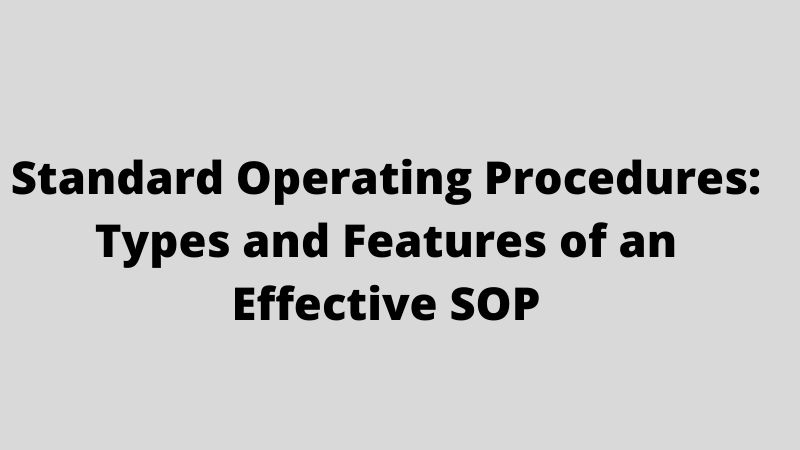The success of an organization depends on different factors that work together to enhance productivity. Productivity is thus the ultimate goal of any organization that desires to make profits and minimize costs. Standard Operating Procedures are the guidelines that ensure that best practices are followed throughout the production process. They provide efficiency, time consciousness, and uniformity in production.
Imagine an organization without SOPs. What would be the source of employee motivation, how would the management do employee performance appraisals and promotions, how would the hiring process be like? There would perhaps be so many unanswered questions and confusion due to the lack of a framework to grade performance.
Types of SOPs.
There are different sop types when it comes to the design of a Standard Operating Procedure. The choice of SOPs depends on the various considerations made by the designer. Below we look at the most commonly available SOPs.
Step-by-step SOP.
This is the easiest of all SOPs. It spells out the steps an employee would take while performing a task from the beginning to the end. It is mainly applicable where the task at hand is simple and does not require complex procedures within each of the steps.
Merits:
- It’s simple to make, understand and use by whoever needs it.
- Effective where the task is a routine.
- It does not require any special skills and training to follow.
Demerits:
- It’s not suitable for complicated procedures.
- A mistake in any of the steps will translate to failure.
- Some steps may be assumed or omitted by the creator while preparing.
Flowchart SOPs.
Flowcharts are easy to understand and follow through. They are non-linear representations on a chart that show the possible results of a process and the steps after that. They are common in industrial processes such as distillation. They can also be used in service delivery, counseling among other avenues where deemed fit.
As the name suggests, the chart shows the directions a procedure takes before achieving the desired result. They could also show where different materials are introduced, recycled, or removed.
Merits:
- Reduces the chances of confusion and ambiguity where outcomes in a particular step are many.
- They aid in decision-making.
- They explain complex procedures more simply.
- Flowcharts can turn out to be useful in cases where outcomes are unknown.
- They can be helpful in the training of junior staff and recruits.
Demerits:
- Some items in flowcharts may be presented in initials or chemical symbols, especially in industrial processes which ordinary users may not understand.
- If a flowchart needs some information included, this may not be easy since one has to do an entire flowchart.
- Inadequate office space in an organization may render the use of flowcharts ineffective due to lack of display space.
Management SOPs.
This refers to the SOP that guides the preparation of other SOPS. While preparing an SOP in lower departments of a large organization, guidelines already established for preparing SOPs by the management must be followed. Such procedures include layout, reviews, approvals, controls, maintenance, and implementation of new SOPs. It ensures that new SPOs are standard and consistent with older SOPs within the organization.
Merits:
- Assist newbies in the preparation of SOPs by following the management SOPs.
- Eradicate the possibility of contradictions between new SOPs and existing SOPs.
- Ensure adherence to ethics, government policies, laws, and regulations.
- The process is simplified and faster, and creators of new SOPs do not have to scratch their heads anymore.
Demerits:
- Preparation of the original management SOP could be complex since it’s not specific to a particular task.
- A mistake in the management SOP would render all other SOPs prepared under it wrong. It could be fatal to the objectives of the organization.
- Management SOPs must be reviewed, updated, and checked regularly to ensure compliance.
Hierarchical SOPs.
A hierarchical SOP is the better version of the step-by-step SOP. It tries to eliminate the weaknesses posed by the step-by-step SOP. Whereas the step-by-step SOP simplifies the procedure of a task into simple steps, the hierarchical SOP goes further to include sub-steps in each step of the process. The steps may be numbered in unique ways to explain further details and reduce the chances of confusion and ambiguity.
Merits:
- All information necessary is included in each step.
- Information is presented neatly and in an understandable format.
- Newbies can follow without any prior knowledge.
Demerits:
- Hierarchical SOPs do not provide room for creativity, innovation, or improvisation.
- Editing any of the steps can be involving, especially where one step necessitates changes in the succeeding steps.
- A mistake in any step confuses the user of the SOP.
Features of an effective SOP.
We can only gauge the performance of an SOP by the overall performance of the organization or different departments upon implementation of the SOP. Does it reduce the time taken to perform specific tasks in various departments? Does it minimize costs and maximize profits? What’s its overall effect on employees’ morale?
The following are some of the features.
Communication.
Where communication breaks down in an organization, then success is not guaranteed. An effective SOP defines employees’ roles, responsibilities, and expectations. This motivates them and ensures productivity, thus contributing to organizational success.
Consistency.
You need SOPs to ensure that the performance of different tasks. You need some standards and practices maintained throughout the production process. This serves as the background for employee training, motivation, performance appraisals, and promotions. Thus, an effective SOP must be in a position to deliver consistency.
Error minimization.
Man is to error, as they say. We need SOPs to ensure that we have no or minimal errors in our performance. Therefore, where steps are followed keenly and correctly, the possible errors in the end products are few.
Safety.
An SOP must guarantee the safety of the performer. All safety requirements must be spelled out in the guidelines, ensuring the safety of the employees while following the SOP.
Conclusion.
The usefulness of SOPs outweighs their demerits by far. Any organization that desires success and uniformity in productivity must employ SOPs in the process. SOPs will assist in the various ways explained above and much more. Get yourself one and see your revenues multiply.




